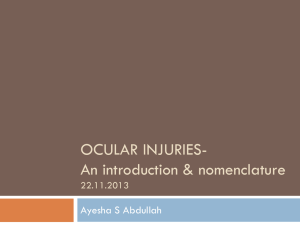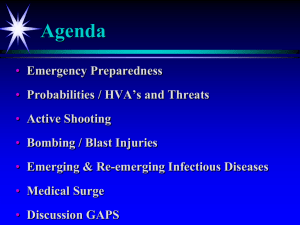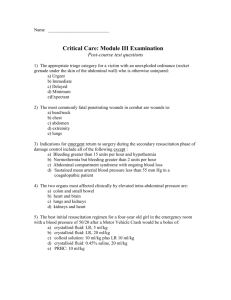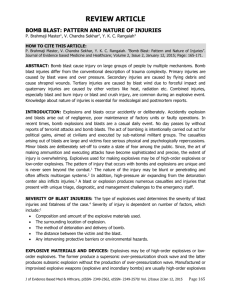Posterior Segment Trauma secondary to IED
advertisement
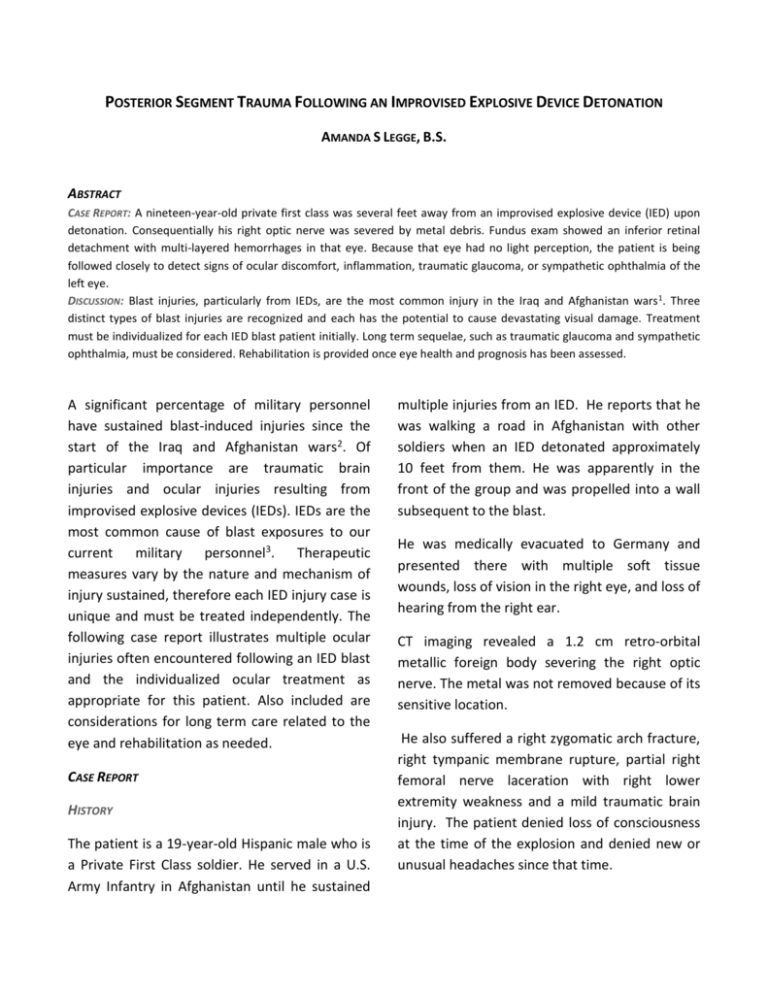
POSTERIOR SEGMENT TRAUMA FOLLOWING AN IMPROVISED EXPLOSIVE DEVICE DETONATION AMANDA S LEGGE, B.S. ABSTRACT CASE REPORT: A nineteen-year-old private first class was several feet away from an improvised explosive device (IED) upon detonation. Consequentially his right optic nerve was severed by metal debris. Fundus exam showed an inferior retinal detachment with multi-layered hemorrhages in that eye. Because that eye had no light perception, the patient is being followed closely to detect signs of ocular discomfort, inflammation, traumatic glaucoma, or sympathetic ophthalmia of the left eye. DISCUSSION: Blast injuries, particularly from IEDs, are the most common injury in the Iraq and Afghanistan wars 1. Three distinct types of blast injuries are recognized and each has the potential to cause devastating visual damage. Treatment must be individualized for each IED blast patient initially. Long term sequelae, such as traumatic glaucoma and sympathetic ophthalmia, must be considered. Rehabilitation is provided once eye health and prognosis has been assessed. A significant percentage of military personnel have sustained blast-induced injuries since the start of the Iraq and Afghanistan wars2. Of particular importance are traumatic brain injuries and ocular injuries resulting from improvised explosive devices (IEDs). IEDs are the most common cause of blast exposures to our current military personnel3. Therapeutic measures vary by the nature and mechanism of injury sustained, therefore each IED injury case is unique and must be treated independently. The following case report illustrates multiple ocular injuries often encountered following an IED blast and the individualized ocular treatment as appropriate for this patient. Also included are considerations for long term care related to the eye and rehabilitation as needed. CASE REPORT HISTORY The patient is a 19-year-old Hispanic male who is a Private First Class soldier. He served in a U.S. Army Infantry in Afghanistan until he sustained multiple injuries from an IED. He reports that he was walking a road in Afghanistan with other soldiers when an IED detonated approximately 10 feet from them. He was apparently in the front of the group and was propelled into a wall subsequent to the blast. He was medically evacuated to Germany and presented there with multiple soft tissue wounds, loss of vision in the right eye, and loss of hearing from the right ear. CT imaging revealed a 1.2 cm retro-orbital metallic foreign body severing the right optic nerve. The metal was not removed because of its sensitive location. He also suffered a right zygomatic arch fracture, right tympanic membrane rupture, partial right femoral nerve laceration with right lower extremity weakness and a mild traumatic brain injury. The patient denied loss of consciousness at the time of the explosion and denied new or unusual headaches since that time. Prior to the blast, the patient’s medical and ocular history was unremarkable. dilated O.D., but anatomically normal, and normal O.S. The soldier presented to our office two months after the blast injury. At that time he was medicated with Oxycodone 5mg / APAP 325mg as needed. He was using prednisolone acetate 1% four times a day and erythromycin ointment four times a day in the right eye. Hertel exophthalmometry with base 105 was 13mm O.D. and 11mm O.S. The patient did not report any discomfort with his eyes. He denied any visual or mobility issues secondary to his monocular status. However he did admit being slightly nervous while driving, especially when merging into a new lane. DIAGNOSTIC DATA Upon our evaluation, 8 weeks after the blast, the patient’s unaided visual acuity was no light perception O.D. and 20/20 O.S. at distance and near. The right pupil was fixed and dilated, the left was normally reactive. Extraocular motility testing found no restrictions of muscle movement. Confrontation visual fields were full to finger counting O.S. Intraocular pressures were measured to be 13mm Hg O.D., O.S. Anterior segment evaluation revealed a well-healed horizontal scar on the upper and lower lids of the right eye with resulting mild cicatricial ectropion of the lateral lower lid. The left lids were normal. A resolving subconjunctival hemorrhage was noted supratemporally in the right eye with minimal injection inferiorly and associated mild diffuse chemosis O.D. The left conjunctiva was white and quiet. The corneal surface was smooth O.U. The right anterior chamber had 3+ cells, most were pigmented, and 1+ flare. The left anterior chamber was deep and quiet. The iris was widely Humphrey 30-2 visual field O.S. showed no signs of visual pathway damage at or behind the chiasm. Gonioscopy revealed the most posterior structure in all quadrants to be the ciliary body face with minimal pigment O.U. There was no sign of angle recession or microhyphema O.D. Posterior segment examination of the right eye revealed a dense, recent, vitreous hemorrhage as well as a preretinal hemorrhage obscuring the optic nerve. A significant, resolving, vitreous hemorrhage was settled inferiorly near a localized retinal detachment. Due to bleeding, the extent of the detachment could not be determined; however all other visible retina was flat and attached. The left posterior segment showed normal anatomy with a cup-to-disc ratio of 0.6/0.55. DIAGNOSIS AND MANAGEMENT Surgical repair of the retina would be of no benefit because of the optic nerve severance. Although once the vitreal hemorrhages resolve, the entire retina can be assessed and retinal repair may be considered. The patient understands this would not restore his vision. The goal of the surgery would be to stabilize the nerve lining. This would allow for the possibility of a future intervention such as stem cell regeneration to the optic nerve and therapeutics that promote neural recovery5. The patient was thoroughly educated of the findings. Adaptation to his monocular status was discussed. A motor vehicle education course was offered to aid in monocular adaptation to driving. This course would also suggest additional mirror placement on the vehicle to aid in awareness to his right periphery. He declined the offer at this time. He continued to use prednisolone acetate 1% four times a day until the right intraocular inflammation decreased. After 2 additional weeks of treatment the steroid was appropriately tapered. An oculoplastics consultation was suggested for the right lower lid ectropion. He declined at this time. He continues with GenTeal gel drops at night to protect the cornea from exposure keratopathy. Baring any change or setback, the patient will be monitored at four month intervals for one year to monitor for any signs of ocular discomfort, increased inflammation, traumatic glaucoma of the right eye, or sympathetic ophthalmia of the left eye. Protective eye wear and monocular safety was discussed with the patient. A pair of polycarbonate lenses was dispensed to be worn on a daily basis. A pair of safety goggles and sun lenses were dispensed to the patient for when he returns to active duty in a few months. DISCUSSION IEDs are the most common cause of blast injury in the Iraq and Afghanistan wars3. These are typically fabricated from a 155-mm artillery shell buried under asphalt. It is commonly triggered by a cell phone from a remote location. The shell is composed of improvised, easily obtainable, shrapnel that may also be associated with flammable explosion1. substances to enhance the Three distinct categories of blast injuries are recognized based on mechanism of structural damage. Primary blast injuries are caused by the changes in atmospheric pressure from the blast waves itself. Secondary wounds are related to foreign bodies from the metal casing or other materials projected from the IED. Tertiary injuries are caused via the propulsion of the victim from the blast into a stationary object and result in a sudden, halting, impact4,5. This patient presumably suffered all three types of blast injuries, although there is arguable evidence that primary blast injuries are sustained in survivors of explosions6. Each of these mechanisms of blast injury can easily cause visual impairment. Percussive forces can disrupt axons of the many nerves responsible for clear and single vision. Penetrating injuries, the majority of ocular injuries sustained in a blast6, can be responsible for a multitude of ill effects based on trajectory and endpoint. Visual impairment resulting from blast injuries can range from mild to severe. The most common cause of severe vision loss is secondary to optic nerve and retinal damage, or globe rupture7. Other common causes of moderate to severe visual impairment include diplopia, corneal scar opacities, large hyphema, and vitreal hemorrhage8,9. Treatment must be individualized to each IED blast patient based on the nature and mechanism of each injury sustained. A meticulous history must be obtained to elicit the possible extent of all injuries. Careful inspection of the eyes is necessary to rule out an intraocular foreign body or globe rupture. Then injuries must be documented in detail. traumatized eye14 or any vision loss in the subsequent eye13. After any initial surgeries, final visual outcome can be predicted in approximately four weeks. An initially poor visual acuity does not guarantee a similar end result5. In some cases, minimal therapeutics and frequent monitoring is the most appropriate treatment, as in this case. Rehabilitative care is needed once eye health is stabilized and prognosis is assessed. This must also be individualized to the patient’s injuries and concerns. Rehabilitation may include the use of prism to neutralize diplopia or nystagmus, visual spatial training, accommodative and/or vergence facility training, ocular prosthetics, mobility training, or driving education8. Two long term considerations following ocular injury from an IED blast include traumatic glaucoma and sympathetic ophthalmia. Each can present within a few days to many decades after the initial injury10,11,12,13. Careful follow up and patient education is required to detect these issues early and prevent evisceration of the IEDs can cause multiple and diverse injuries throughout the body. Visual outcome greatly varies by the type and extent of blast injury sustained. Therefore it is important to consider each case individually with regard to initial treatment, long-term care, and rehabilitation. REFERENCES 1 Hyer, R., Iraq and Afghanistan Producing New Pattern of Extremity War Injuries. Medscape Medical News, 2006. Accessed 4 January 2012: <http://www.medscape.com/viewarticle/528624>. 2 Okie, S., Traumatic Brain Injury in the War Zone. N Engl J Med, 2005; 352: 2043-2047. 3 Cockerman, G., et. al., Closed-Eye Ocular Injuries in the Iraq and Afghanistan Wars. N Engl J Med, 2011; 364: 2172-2173. 4 Elder, G., Christian, A., Blast-related Mild Traumatic Brain Injury: Mechanisms of Injury and Impact On Clinical Care. Mt Sinai J of Med, 2009; 76(2): 111-118. 5 Scott, R., The Injured Eye. Philos Trans R Soc Lond B Biol Soc, 2011; 366 (1562): 251-260. 6 Abbotts, R., Harrison, S.E., Cooper, G.L., Primary Blast Injuries to the Eye: A Review of the Evidence, J R Army Med Corps, 2007; 153(2): 119-123. 7 Weichel, E.D., et. al., Combat Ocular Trauma Visual Outcomes during Operations Iraqi and Enduring Freedom, Ophthalmology, 2008 Dec; 115(12): 2235-2245. 8 Cockerman, G., et. al., Eye and Visual Function in Traumatic Brain Injury. J of Rehab Res and Devel, 2009; 811-818. 9 Thach, A.B., et. al., Severe Eye Injuries in the War in Iraq. 2003-2005. Ophthalmology, 2008 Feb; 115(2): 377-382. 10 Wills Eye Hospital. The Wills Eye Manual: Office and Emergency Room Diagnosis and Treatment of Eye Disease. 5th ed. Philadelphia, Pa: Lippincott; 2008. 11 Bai, H.Q., et. al., Causes and Treatments of Traumatic Secondary Glaucoma. Euro J Ophthal, 2009 Mar-Apr; 19(2): 201-206. 12 Freidlin, J., et. al., Sympathetic Ophthalmia after Injury in the Iraq War. Ophthal Plastic Reconst Surg, 2006 Mar; 22(2): 133 134. 13 Birnbaum, A.D., Tessler, H.H., Goldstein, D.A., Sympathetic Ophthalmia in Operation Iraqi Freedom. Am J Ophthalm, 2010 Nov; 150(5): 758-759. 14 Chaudhry, I.A., et. al., Current Implication and Resultant Complications of Evisceration Ophthalmic Epidemiol, 2007 Mar Apr; 14(2): 93-97.



